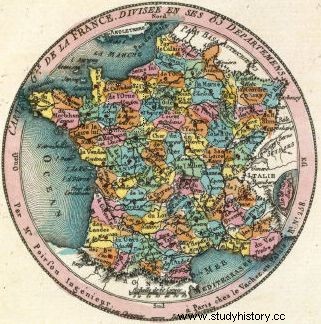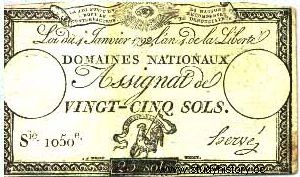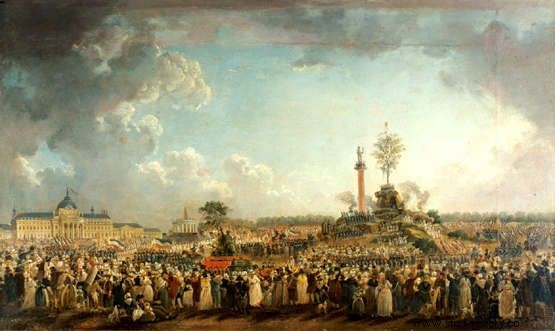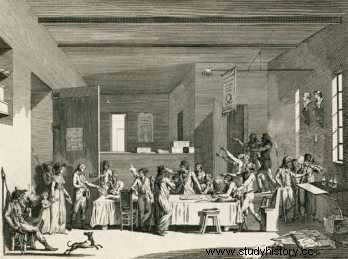The first governments
Abolition of Privileges
The storming of the Bastille, on July 14, 1789, had put an end to the royal authority, very quickly the revolutionary gear was put in place. The devastation of castles throughout France was a valid pretext to suppress feudalism. On this night of August 4, the deputies of the Constituent Assembly abolished the tithe, the salt tax, the right to hunt as well as all the privileges of the Old Regime. These principles were immortalized by the “Declaration of the rights of man and of the citizen”:separation of powers, religious freedom, equality in law, but this declaration retained the inviolable character of private property. However, universal suffrage is not enforced, gender equality is not respected, and other principles of equality were not implemented in the constitution.
The Constitution of 1791
The Assembly of Deputies of 1789 now finds itself the role of Constituent Assembly, it must draw up a new constitution for France and continue the implementation of reforms. In 1791, the Constitution was definitively drawn up. Louis XVI retained executive power but lost his title of King of France in favor of that of King of the French. He is the head of the armies, appoints the senior civil servants and his ministers, he signs the treaties but he can only declare war with the agreement of the Assembly. This assembly holds the legislative power. But this first constitution turns out to be clumsy in many areas, and the Assembly has no power over the executive and vice versa, so there is no coordination between the two movements. Only active citizens (paying a direct tax equal to three working days) are invited to elect delegates (paying a tax for ten working days) who will vote for deputies.
Allegory of the constitution of 1791
Holding in his left hand the Constitutional Charter and in his right hand a spade surmounted by the Phrygian cap, the Constitution faces the people and the national guard. Above her, an angel protects her by slaying her enemies

The Constitution of 1791
The reforms of the Constituent Assembly
The administration is upset by the abolition of the provinces in favor of 83 departments subdivided into districts and cantons and assigned a chief town. The councils which directed the districts and communes were elected by the active citizens, thus the middle-class seized the departmental administration which was completely independent of the central power. In the judicial field, judges and jurors are elected by active citizens, they are under the supervision of the Assembly and can be contradicted by a court of cassation. The taxes were distributed according to the departments and the municipality took care of collecting them, but many municipal officers could not read and write, the taxes were at the beginning object of an insufficient rent. Important reforms were ratified (adoption of the tricolor flag, end of hereditary nobility, non-Catholics became eligible...), finally the guillotine was adopted by the Assembly under the proposal of Dr Guillotin (who did not invented!).
France and its 83 departments in 1790

(Historical Center of the National Archives)
Solutions to the economic crisis
In 1789, France experienced a serious economic crisis, capital and trade were in decline and taxes were falling badly. It was therefore necessary to find a source of money in quantity. Talleyrand then proposed a nationalization of the property of the clergy, the coffers of the clergy contained approximately 2 billion pounds. The debate was stormy, for some it was a question of transgressing private property (Sieyès) for others it was only the gift of the faithful therefore belonging to the Nation (Mirabeau). The proposal was adopted, in return, the Nation took care of paying the clergy. Then very quickly, a decree gave the possibility of paying with assignats (notes) which replaced the metal currency. This was to help sell the property of the clergy more easily. But this paper money was quickly depreciated and inflation galloped. The assignat was to know a perilous existence.
Assignat of twenty-five sols

The Civil Constitution of the Clergy
After the nationalization of the property of the clergy, the Church was to undergo important modifications. The clergy was organized by jurists apart from theologians. The bishoprics are reorganized, the bishops and parish priests were now elected, whereas the pope once had the task of appointing the bishops. The Church of France was thus modified in order to make it more secular under the name of Civil Constitution of the Clergy. The king had accepted the constitution, but Pope Pius VI condemned it. And the clergymen, taken by time, were obliged to take the oath to the constitution, but because of the position of the pope few of them did so. Thus elections were held to replace these refractory priests. This constitution proved to be schismatic and called into question the link between the pope and the Church of France established in the Concordat of 1516.
The Legislative Assembly
Dice the proclamation of the Constitution of 1791, a new assembly named Legislative Assembly was set up, this one signed under the proposal of Grégoire the abolition of slavery following the colonial problems. She had to face the beginnings of the war and the fall of the monarchy. The day after August 10, it was decided to set up a new assembly which took into account the fall of the monarchy. This took the name of Convention. And from September 21, 1792, the first meeting took place, the Republic was born.
The Terror
The revolutionary government
After many difficulties, a Constitution had been drafted (Saint-Just and Hérault de Séchelles were the main drafters). But it was kept in a safe forever, the deputies decreed that the government would be revolutionary until peace. This was to redress the internal and external situation of France, and benefited from the support of the sans-culottes.
- The Committee of Public Safety :It dominates this government, it is made up of eleven members re-elected every month who share the tasks:Robespierre and his right-hand man Saint-Just take care of internal policy, Collot d'Herbois and Billaud-Varennes take charge interiors, Carnot the war...
- General Security Committee :He watches over the security of the State, has the citizens arrested by putting them before the revolutionary tribunal. It's a kind of police ministry of which Vadier, Le Bas and David are the main members.
- Finance Committee :Cambon was the president, this committee was to ensure the recovery of the economy and the financing of the war.
- Representatives on Mission :Appointed by the Committee of Public Safety, these representatives were to inspect the departments (in part to regulate the federalist revolts), they control the armies and make the levies of men. Barras or Tallien were among these members. Supervisory committees were created everywhere to issue and verify the security cards that ensure good citizenship and citizenship of the people.
- The Revolutionary Tribunal :This tribunal must quite simply judge and condemn the suspects and enemies of revolutionary values (freedom, equality, etc.). The provincial revolutionary courts will subsequently be reinforced but they will be abolished in favor of a single one located in Paris. The public prosecutor Fouquier-Thinville took care of providing the victims, so the guillotine was going to be fiercely used under his impulse. Witnesses were not always heard and many miscarriages of justice occurred during this period.
Allegory of the Republic
The first representations of a woman in a Phrygian cap, an allegory of Liberty and the Republic, appeared during the French Revolution. The appellation of Marianne derives from Marie-Anne (a very common first name in the 18th century). A symbol of freedom, the Phrygian cap was worn by freed slaves in Greece and Rome. Under the Third Republic, statues and especially busts of Marianne multiplied, especially in town halls. It also appears on very widely distributed objects such as coins or postage stamps.

Allegorical figure of the Republic - by Antoine-Jean GROS (Fabre Museum)
France under the Terror
A single man was then at the head of the Nation:Robespierre, his opponents had all passed on the scaffold. The power of the departments was losing influence to the benefit of the Committee of Public Safety. “The incorruptible” as he is nicknamed progressed towards dictatorship. Despite previously expressed desires, a general division of property did not take place, however large fortunes were diminished. The external situation was favorable, the victories of the generals (Pichegru, Jourdan, Dugommier...) and the battle of Fleurus insisted on the fear of the Allies.
The Supreme Being
The dechristianization and massacres of the Hébertists had caused Robespierre to react, establishing a cult of the Supreme Being every tenth day of a decade (instead of Sunday). Robespierre had been under the deist influence of the Enlightenment and in particular Rousseau ("France recognizes the existence of the Supreme Being and the immortality of the soul." ). He saw in it a metaphysical foundation of republican ideals and the communion of revolutionary principles. The first of the decade-long feasts of the Supreme Being took place on 20 Prairial (June 8), the ceremony was inspired by Antiquity and was prepared by David (whose paintings bear witness to the aestheticism of Antiquity). Garlands, basket of flowers and white dresses adorned the show. The president of the ceremony, Robespierre burned a statue representing Atheism and another representing wisdom (which remained incombustible). This great party where Robespierre was at his peak also contributed to his downfall.
The Ceremony of the Supreme Being

Feast of the Supreme Being at the Champ de Mars (20 Prairial Year II - June 8, 1794) - by Pierre-Antoine DEMACHY 1794 (Carnavalet Museum)
The last governments
The Thermidorian period
After the Terror, France was exhausted, misery set in, prices rose. To this must be added poor harvests and a harsh winter, the "hollow bellies" are multiplying. The peasants and soldiers are nevertheless satisfied with their new conditions, but there are now the new rich who speculate and exhibit their gold. Morals are relaxed, the too heavy Terror gave way to parties and balls, divorces increased rapidly. The separation of Church and State is now final by the suppression of the civil constitution of the clergy. But inflation was galloping, so they began to devalue the assignats.
The Constitution of Year III
Naturally a new constitution was established after the fall of the Terror. Former Girondins and moderates such as Boissy d'Anglas took care of writing it. The executive power belonged to five Directors where one of them was re-elected every year. They took care of appointing ministers and generals and of state security, they were chosen by the legislative chambers. Five commissioners looked after the Treasury. Legislative power was entrusted to two chambers:the Council of Five Hundred composed of 500 members who initiated laws) and the Council of Elders (comparable to the current Senate) which accepted or revoked the laws proposed by the Five Hundred. . Both chambers sat in the Tuileries. The judicial power was clearly separated from the other two with justices of the peace, departmental and a court of cassation. Citizens paying a direct contribution elected grand electors who would elect members of the legislative and judicial powers.
The Directors
From 1795 to 1799, the various directors were:Barras, Reubell, La Revelliere Lepeaux, Carnot, Letourneur, Barthélemy, Neufchâteau, Douai, Treilhard, Sieyès, Ducos, Gohier, Moulin.

Abbé Sieyès in Director's costume
The Executive Board
Like the revolutionary government, the Directors share the tasks. Carnot:war, Reubell:diplomacy, Barras:internal affairs... New political clubs are reborn, the club of the Pantheon and that of Clichy are the most important. The most important problem was the economic situation, a large loan was taken out and the assignat, which continued to devalue, was abolished. But after inflation, there is deflation, we borrow from conquered countries, we sell national assets at auction. The bankruptcy of two thirds is promulgated, and only the victories of Bonaparte and the peace of Campoformio returns the popularity of a contested regime.
Revolution Appendices
The Republican Calendar
A republican calendar was adopted in order to stand out once again with the Old Regime. The years and centuries with the birth of Jesus Christ as their reference were forgotten. 1792 marks Year I, 1793 Year II... The Republican year is made up of 12 equal months of 30 days, followed by five or six additional days, also called Sans-Culottides (this last name is given in honor to sans-culottes). Each month is broken down into three decades. The days of each decade are primidi, duodi, tridi, quartidi, quintidi, sextidi, septidi, octidi, nonidi, decadi. Decadi replaced Sunday and was the day off. The Sans-Culottides, which were holidays to end the year, are Virtue Day, Genius Day, Labor Day, Opinion Day, Rewards Day, Revolution Day . Moreover, to forget all the saints that the Gregorian calendar had given us, each day of the year was associated with an animal, a plant, or an agricultural tool...
The months of the Republican calendar
- The autumn months (ending in -aire)
- Vendémiaire (harvest month)
- Brumaire (the month of mist)
- Frimaire (the cold month)
- The winter months (ending in -ose)
- Nivôse (the month of snow)
- Pluviôse (the month of rain)
- Ventôse (the month of the wind)
- Spring months (ending in -al)
- Germinal (the month of germination)
- Floréal (the month of flowers)
- Prairial (the month of the meadows)
- Summer months (ending in -or)
- Messidor (the month of harvest)
- Thermidor (the month of heat)
- Fructidor (the month of fruits)
The twelve months of the Republican calendar

Governments
- The National Constituent Assembly (1789 - 1791) :This assembly had both a legislative role and the task of drafting the constitution of France. It proclaimed its own dissolution in favor of the Legislative Assembly.
- The Legislative Assembly (1791 - 1792) :The Legislative Assembly, elected by the active citizens, was the parliament of the constitutional monarchy, then, after the fall of the king, of the republic.
- The National Convention (1792 - 1795) :It meets for the first time on September 20, 1792 and proclaims the republic two days later. After the fall of Robespierre, the convention is generally called the Thermidorian Convention. Three committees of the National Convention had an important role:
- The Committee of Public Safety:During the Terror, this committee was the real government of France.
- The General Security Committee:Responsible for coordinating the war effort.
- The Public Instruction Committee
- The Directory (1795 - 1799) :Dominantly bourgeois bicameral regime. Its two bedrooms are:
- The Council of Five Hundred
- The Council of Elders, or Senate
A revolutionary committee under the Terror

Interior of a revolutionary committee under the Terror - by C.N. Malapeau (Historical Center of the National Archives)
Political groups
- Royalist Political Groups
- Monarchists or Royalists:Supporters of the Bourbon monarchy, in its absolute form or in its constitutional form.
- Chouans:Counter-revolutionary groups active in the western regions and the Vendée marshes. They will disappear under the Empire.
- Emigrants:Members of the nobility who left France, often for England, to flee the Revolution.
- Resisters:Religious who, having refused to take the oath to the Republic, must go underground.
- Republican Political Groups
- Republicans:Supporters of a system without a king.
- Girondins:Group of twelve Republican deputies, more moderate than the Montagnards. Sometimes called (by amalgamation), Brissotins.
- Montagnards:Often members (or ex-members) of the Jacobins, the Montagnards were radical republicans in power during the Reign of Terror. Their role model remains Robespierre.
- Thermidorians:More moderate Republicans who seized power after the fall of Robespierre and the Montagnards on 9 Thermidor.
The composition of the various assemblies
The question of the king's veto in 1789 had divided the Assembly into two camps which grouped themselves on the right of the king (for the veto) or on the left (against the veto). This cleavage is at the origin of our current political parties. As a result, the king's supporters and the most conservative sat on the right while the supporters of change and revolution sat on the left. The most "enraged" were placed on the extreme left on the upper spans of the top of the Assembly, the "Mountain". Also the members of the most revolutionary tendency of the Assembly received the name of "Montagnards" (Marat, Danton, Robespierre...). The Gironde (Roland, Vergniaud, Brissot...) included deputies from the Bordeaux region or from the provinces, they were placed on the left and they were initially close to the Mountain. The Constituent and then Legislative Assembly included on its right the aristocrats in favor of the old order and others more moderate who preferred a constitutional monarchy. Thereafter, the aristocrats emigrated or withdrew, the moderates like Mounier gradually disappeared from the Assembly. So that when the Republic was proclaimed, it was the Gironde which took its place on the right, and the Montagnards remained on the left. From 1792, the two parties clashed violently. The majority of the Assembly constituted the "plain" or the "marsh" because they sat in the center, they were initially close to the Girondins but part of them joined the Montagnards. These deputies subsequently took power after 9 Thermidor.
Revolutionary vandalism
The fall of the monarchy on August 10, 1792 led to an outbreak of violence against the visible symbols of feudalism. The Committee of Public Safety decided to commemorate the fall of the monarchy by destroying the sumptuous mausoleums of the kings, preserved in the abbey of Saint-Denis. Part of the tombs were demolished and melted down to make balls and cannons.

The violation of the vaults of kings in the Saint-Denis basilica, in October 1793 - by Hubert ROBERT (Musée Carnavalet)
Clubs
The deputies met in clubs where they continued the debates of the Assembly with their supporters, they met in former convents, and they adopted their names.
- The Jacobin Club :Originally, Breton patriots who founded the Breton club, arrived in Paris during the Estates General, they met at the Jacobin convent. The Jacobins gathered around them the revolutionary left and constituted the governing body of the Mountain after the Girondins of Brissot were driven out. The principal members were Pétion de Villeneuve and Robespierre. Closed after Thermidor, they fall at the same time as Robespierre. Their motto:"Live free or die".
- The Feuillants club :Most of them come from the Jacobin club, which they left because they were more moderate. Their leaders were Talleyrand, Sieyès, La Fayette and the men of the triumvirate (Barnave, Lameth, Duport) who were popular. But they were divided (partisans of La Fayette against those of Lameth), the club disappeared on August 10 during the fall of royalty. And the Girondins took their place on the right of the Assembly.
- The Cordeliers Club :Just like the Jacobins, the Cordeliers relied on the discontent of the Parisian people and were the favorites of the sans-culottes. Among the most famous members:Danton, Marat, Hébert and Camille Desmoulins. The club organized the great revolutionary days such as August 10, and persisted in bringing down the Gironde. They separated into Indulgents (Danton), Enrages (Roux) and Hébertistes (Hébert). The survivors later joined the Jacobins.
Popular movements
- The sans-culottes :They are the Parisian people (workers, craftsmen, small traders), they were so called because they wore homespun trousers instead of the knee-length pants that the nobles and bourgeois wore. They intervened more and more actively to force the assembly to take measures favorable to the people. They were divided into neighborhood sections led in particular by Hébert and Roux. The sans-culottes played a decisive role (taking the Bastille, the Tuileries, the fall of the Girondins), their most famous song was "La Carmagnole".
- The Enrages :One of the sections of the sans-culottes directed by the priest Jacques Roux. Mainly active in Paris and Lyon during the Gironde convention, it advocated the use of severe measures against the rich and the formation of a people's army. Robespierre had their leaders guillotined during the Terror.
- The Hebertists :Another section of sans-culottes led by Jacques Hébert, and also Collot d'Herbois. This had a great influence on the Cordeliers and the insurrectionary commune. Like the (indulgent) Dantonists, the Hébertists distanced themselves from Robespierre, who had them guillotined.
- The Indulgents :Led by Danton, the Indulgents brought together Mountain dwellers hostile to the Terror. The accusations of conspiracy against Danton will mark the end of the movement, at the same time when the ax will fall on him and his supporters including Camille Desmoulins.
- The Paris Commune :Municipal government of Paris born in July 1789, on August 10, the insurgents overthrow it and it gives way to the insurrectionary Commune where the sans-culottes have control. It will henceforth apply the revolutionary policy and therefore also that of Robespierre's Committee of Public Safety. Hébert tried to oppose the Terror as he had such an influence on the Commune. But the reaction of the Thermidorians descended on her, and stripped her of all her powers.
Glossary
- The Constitutions
- Constitution of September 3, 1791:It establishes a parliamentary monarchy and the Legislative Assembly.
- Constitution of Year I or June 24, 1793:Republican Constitution, never applied.
- Constitution of Year III or August 22, 1795:It establishes the Directory.
- Constitution of year VIII or of December 13, 1799:It establishes the Consulate.
- Coups
- 9 Thermidor Year II:Fall of Robespierre and the Mountaineers (July 27, 1794).
- 18 Fructidor Year V:A coup against the attempted monarchist restoration (September 4, 1797).
- 22 Floréal, Year VI:Coup in which 106 left-wing deputies were deprived of their seats (May 11, 1798).
- 30 Prairial Year VII:Coup prepared by General Joubert, by which four directors were forced to resign (June 18, 1799).
- 18 brumaire year VIII:The blow that brought Napoleon Bonaparte to power (9 November 1799).
The press during the Revolution
Freedom of the press was declared in the Declaration of the Rights of Man. As soon as the Estates General met, Mirabeau published "The Journal of the Estates General" . As soon as freedom was acquired, newspapers multiplied, there are 1,500 periodicals born between 1789 and 1799, most of which were short-lived. Almost all the deputies had their sheet to express themselves:
- "The French Patriot" (Brissot)
- "The Old Cordelier" (Desmoulins)
- "The People's Speaker" (Freron)
- “The tribune of the people” (Babeuf)
- “Friend of the People” (Marat)
- “Father Duchesne” (Hebert)
These last two were very read and coveted by the sans-culottes, Marat and Hébert were their spokespersons. The royalists also had their own newspaper such as “Le Mercure de France” . But the press hardened under the influence of the Directory, which suppressed reactionary newspapers. As soon as the Consulate arrived, Bonaparte hastened to ban this freedom of the press, which generated popular disorder.
